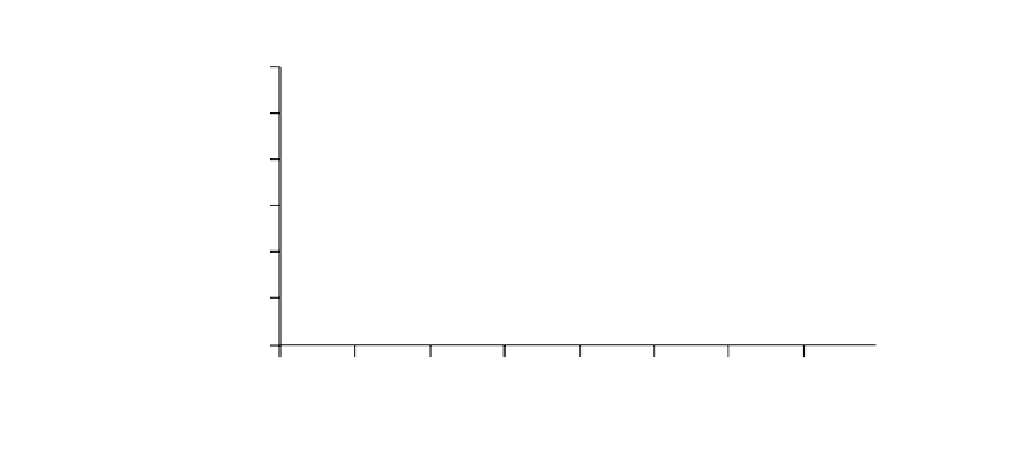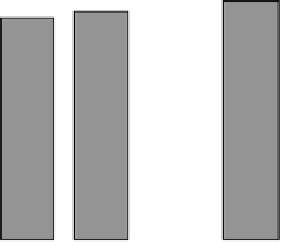Agriculture Reference
In-Depth Information
Because of the inevitability of salt buildup in most irri-
gated systems, long-term sustainability is not possible with-
out adequate natural or artificial drainage that removes the
accumulated salts from the upper layers of the soil. Rainfall
is the primary natural leaching agent. In the absence of suf-
ficient rainfall, it is necessary to construct systems of drains,
ditches, and canals as described above. Excess irrigation
water is applied periodically to dissolve salts, and the salt-
laden water either leaches below the productive root zone or
is removed through surface drainage from the crop fields.
A natural consequence of farming in dry areas where
ET is high and irrigation water carries appreciable salt
loads is that the water leaving the agroecosystem will have
a higher salt concentration than the water applied. Care
needs to be taken, therefore, not to salinize the areas
receiving the outflow, be they soils, the groundwater, or
surface water systems.
quantity of precipitation. The off-farm effects of irrigation
must be considered along with its on-farm effects when
the larger context of sustainability is applied.
OPTIMIZING USE OF THE WATER
RESOURCE
Soil moisture is managed optimally in agroecosystems
designed to ensure that the primary route for water out of
the soil is through the crop. The focus for management,
therefore, is to reduce evaporation and increase the flow
through T. Farming practices that encourage this differential
water movement are important components of sustainability.
E
FFICIENCY
OF
W
ATER
U
SE
The biomass produced by a plant with a given amount of
water can be used as a measure of the efficiency of the
use of water applied to an agroecosystem. When this effi-
ciency is expressed as dry matter produced per unit of
water transpired, it is called transpiration efficiency, and
when it is calculated on the basis of dry matter produced
per unit of water lost through both evaporation from the
soil surface and T, it is called ET efficiency.
E
COLOGICAL
C
HANGES
The introduction of irrigation water into a farming region
during a normally dry part of the year may have profound
effects on natural ecological cycles and the life cycles of both
beneficial and pest organisms. Under natural conditions, sea-
sonal drought may have been a very important means of
reducing the buildup of pests and diseases, acting much as
frost or flooding does in other regions to disrupt the life cycles
of these organisms. Loss of this natural control mechanism
can have serious consequences in terms of outbreaks and
increased resistance to artificial control strategies.
Another type of change that may result from introduc-
ing irrigation into naturally dry areas is local or regional
climate change caused by the increased evaporation from
surface water storage areas or from farm fields where
water is applied. Elevated humidity in the atmosphere can
be connected to increased pest and disease problems, and
might also be associated with shifts in the distribution and
T Efficiency
Plants vary in their relative T efficiencies, although actual
T efficiency depends on the conditions that exist where
the crop is growing. Data suggest that crops such as corn,
sorghum, and millet have relatively high T efficiencies,
since they use less water to produce 1 kg of dry matter.
In contrast, legumes such as alfalfa have low T efficiencies
and depend on high moisture inputs for each kg of dry
matter produced. Most cereal and vegetable crops are
intermediate. Average T efficiencies for a number of
important crop plants are shown in Figure 9.8.
kg of water used in production
of 1 kg of dry matter*
600
500
400
300
200
100
0
Corn
Barley
Wheat
Beans
Peas
Oats
Clover
Potatoes
FIGURE 9.8
Average T efficiencies of various crop plants.
The averages were computed from data compiled by Lyon et al. from
various locations around the world. (From Lyon, T. L., H. O. Buckman, and N. C. Brady. 1952.
The Nature and Properties of Soils.
5th ed. Macmillan: New York.)





Search WWH ::

Custom Search